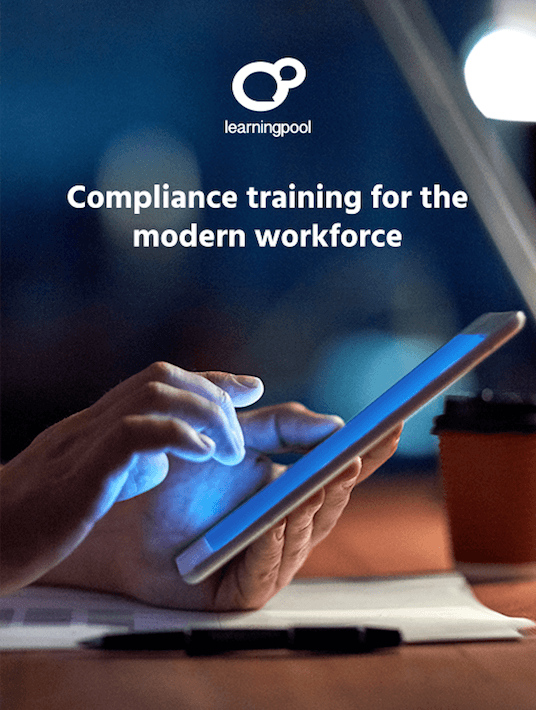Create A Great eLearning Experience In Compliance Using Training Catalogues
In these circumstances effective and easily-adaptable compliance training is key. Yet, too often, compliance training has been ineffective and regarded as irrelevant by employees. And this needs to change.

Here, we’re going to examine the concept of compliance training catalogues, explain what they are, and what they can do for your business. We’ll also take a look at how eLearning catalogues can deliver a better learning experience and provide more effective compliance training.
Training Catalogues
So, what are training catalogues? In essence, a catalogue is a series or suite of courses that are available to learners or potential customers. They can focus on a single theme or cover a broad area like compliance. Typically, these days, courses are delivered by eLearning and may be bundled together with a Learning Management System. Catalogues can be created internally by an organization’s L&D or Training Department or brought in from an external training supplier.
Common areas or topics covered by compliance catalogues include GDPR, Diversity, Health and Safety, Employee Mental Health, and Quality Assurance. You can add to those any number of courses dealing with specific regulatory or fiscal standards in industries such as Manufacturing, Financial Services, and Pharmaceuticals.
Build Or Buy
Just as when acquiring any product, organizations need to weigh up the pros and cons of creating their own eLearning compliance training or sourcing it from an eLearning provider. In making that decision you need to know your audience’s needs, define your learning objectives, and take account of your IT infrastructure and general learning environment.
The advantage of keeping it in-house is that you can ensure that the eLearning you’re creating is bespoke and meets your own learning objectives, culture, and standards. You won’t need to purchase user licenses, and you can control the content. This, however, may be a time-consuming and ultimately too expensive an option, or one that’s simply unfeasible if you don’t have the in-house resources and expertise.
Off-the-shelf courses offer the prospect of being quickly implementable and already tried and tested elsewhere. They may involve customer support and come with regular updates as part of the licensing agreement. There’s the potential to customize and localize them. However, they may lack specific relevance and, although they may claim to be customizable, you might find that in fact, it’s too hard to make them suitable for your organization’s needs.
eLearning Training Catalogues: What They Can Deliver
For many organizations creating eLearning isn’t really an option. They simply don’t have the resources and would have to buy them in. For them, sourcing ready-made eLearning makes sense, so long as it’s flexible and customizable.
But there are other, more positive reasons for choosing to license a suite of eLearning courses.
Firstly, they’ve been designed by learning experts who know how to make training appealing and engaging by grounding the approach in good, solid pedagogy and using the latest developments in eLearning and IT, whether it’s mobile-device compatibility, a Learning Management System, app design, use of social media, gamification, badging, and so on.
Secondly, there’s no need to reinvent the wheel. If a training course is widely used in an industry, you can regard it as having peer approval. It’s likely to be currently the best, if not the last word on compliance for that area. You gain the advantage of being able to leverage global experience and expertise from compliance experts. The courses deliver the benefits of using tried and trusted content that has been developed on behalf of large, leading organizations. If you can then adopt a catalogue to meet your own needs or add your own spin and perspective, you have the best of both worlds: industry-standard content with local relevance.
Fixing The Problem Of Compliance Training
Finding the right course from a content point of view is just the start though. For all the debate about build or buy, the biggest problem with all compliance training has been its failure to engage learners. Surveys repeatedly conclude that compliance training is regarded as dull, a chore, a burden, and, worst and most dangerous of all, irrelevant.
So, when you’re buying in that compliance eLearning product, you need to be sure it comes with the relevant learning expertise that will deliver training that is engaging, appealing, and, most of all, effective.
Making Compliance Training Effective
Not all eLearning compliance catalogues are alike. Some present simple content in a straightforward page-turning, click-through manner with a perfunctory quiz at the end to check compliance. They’re neither interactive nor engaging and risk perpetuating the stereotype that all compliance training is tedious and ineffective.
But modern learning practices using the latest in IT and AI and taking lessons from the growing use of social media and gaming can revolutionize the approach to compliance.
Creating A Better Training Experience
Many new eLearning catalogues contain elements that make the content more accessible, relevant, challenging, and attractive.
For example, presenting learning as a game (gamification) challenges learners to attain targets and rewards progress. The game approach includes the use of timed activities so that learners work against the clock reproducing the kind of pressure they may find themselves in a real-life experience. Learners can see their progress and what they need to achieve via a dashboard or a health bar. Badges or another type of award system reward attainment, give the learner a sense of achievement and motivate him or her to progress further. Gamification actively engages learners in the training and replaces the passivity of the lecture or page-turning format of more traditional courses.
Scenarios, or story-based learning, make training relevant by embedding it in situations that learners recognize and are likely to encounter in their work, rather than presenting them with abstract rules and procedures. Narratives with credible characters mimic the environment in which an employee operates making training more personally relevant. Story-based learning links compliance training directly to job roles and workplace performance. It personalizes training and recognizes that not everyone needs to know or apply the same level or aspects of compliance training.
Content presentation is enhanced by the use of striking and engaging graphics. Custom photography helps situate learning in a recognizable and realistic environment. The use of video and animation make learning more visually engaging and memorable and improve retention.
Making Training Accessible
Whatever training you decide on, it needs to be accessible if you’re to bring compliance fully into the workflow. Mobile access allows support for employees who are on the go and delivers vital information and knowledge at the point where they need it. Mobile connectivity means access to training is available anytime, anywhere.
Accessibility also needs to apply to the learning experience. The ability to customize and localize content can make it more relevant and accessible. The material should be appropriate for your organization’s employees. Ensure your compliance training embodies your company’s core values and approach. Customization also gives you the flexibility to tweak and update elements as your organization’s needs and the compliance environment change.
LMS And Tracking Learners
eLearning training catalogues are often bundled together with an LMS or are easily adaptable to your existing LMS and IT infrastructure. This minimizes the need for wholesale integration and allows you to continue with or add to your existing IT and eLearning infrastructure. Using a training catalogue with an LMS gives you the ability to track learning and ensure your employees are actively engaging with your compliance training. Feedback and data from the LMS can be analyzed and used to update and enhance your training catalogues. This means training becomes iterative and not static, and it maintains its relevance.
A Great Learning Experience
With eLearning training catalogues that use a variety of media and learning strategies to engage learners, compliance training needn’t be dull or ineffective. More than that, training can actively reinforce best practices and integral parts to the workflow giving it more impact. Training is brought closer to performance and becomes truly relevant and effective.
You owe it to yourself to consider the advantages that eLearning compliance catalogues bring, and see how they might fit your organization’s needs.
Sources:
- Catalog eLearning Courses vs Custom eLearning Courses: 6 Factors To Consider
- Top Learning And Development Challenges Faced By Enterprises
- Compliance training. less is more
- The compliance revolution is coming. Are you ready?
- Comply with me, comply, comply away…
- Compliance e-learning
- Regulatory compliance training
- Compliance e-learning catalogue








